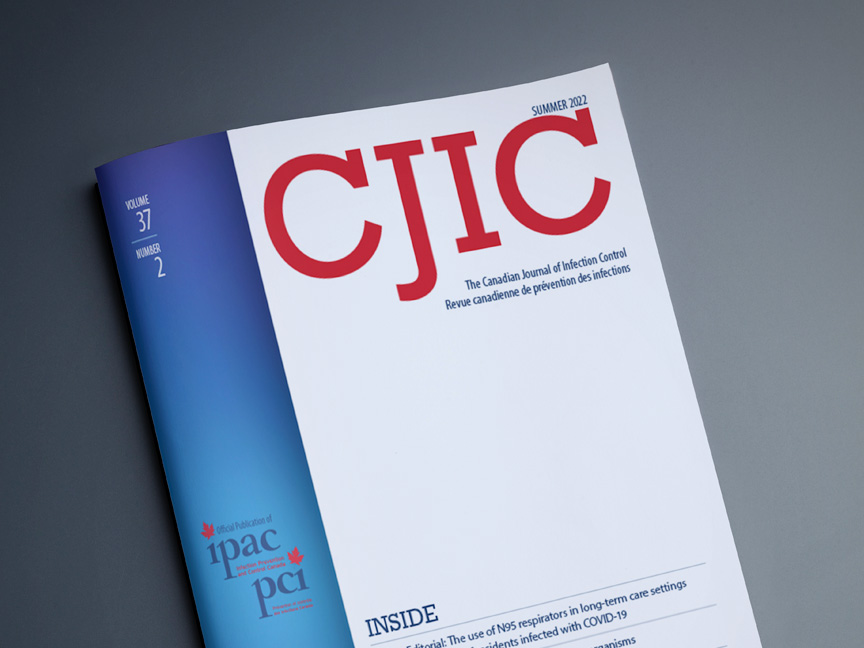Five great ways to reach your infection control professionals in Canada!
CJIC has a pass-along readership of over 6,600 based on statistical research, on average, specialized business publications have pass-along readership rates of 3-4 people per copy.
Jump to Advertising Rates View Digital Edition
IPAC CANADA (Infection Prevention and Control Canada)

IPAC CANADA (Infection Prevention and Control Canada) is a multidisciplinary, professional organization for those engaged in the prevention and control of infections. IPAC Canada was incorporated under the Canadian Corporation Act in 1976 and is a registered non-profit organization. IPAC Canada has over 1500 members.
IPAC Canada is a Not-for-Profit charitable organization whose revenues come from annual membership revenues, conference revenues, commercial advertising and unrestricted grants for specific projects. IPAC Canada does not endorse or recommend the products or services of any commercial entity that advertises on the IPAC Canada website.
IPAC Canada provides communication and education for those involved in infection control activities. Its goal is to prevent infections and as a result improve patient care and staff health in hospitals, other health care facilities, and the community by:
- initiating and coordinating effective communication and cooperation among all disciplines united by infection control activities
- supporting and/or developing effective and rational infection control practices standardizing infection control practices
- promoting research in areas related to infection control
- promoting and facilitating infection control education for both infection control practitioners and other personnel working in hospitals, long term care/continuing care and related institutions.

Regular Features In Every Issue
EXTRA ONLINE EXPOSURE!
Ads placed in the Journal will APPEAR ONLINE AT NO EXTRA COST!

Interactive Edition Available Online
With print and electronic communication operating hand-in-hand, you can take advantage of the fact that The Canadian Journal of Infection Control is available online in a highly interactive format.
A user-friendly, interactive Media Rich PDF format that includes:
- Active hyperlinks to all websites and emails contained in the publication
- Active links to the specific stories from the front cover and contents page
- Active links to advertiser websites from their ads
 WHY PRINT CONTINUES TO MAKE AN IMPRESSION
WHY PRINT CONTINUES TO MAKE AN IMPRESSION
GETTING ATTENTION
There are fewer magazines and print newsletters in the mail, so more attention is paid to each piece.
WHAT'S OLD IS NEW AGAIN
As social media progresses, online content and iPad applications may be overwhelming. More and more people are attempting to disconnect themselves from digital media, feeling overwhelmed by the sheer volume. Many marketers are continuing to leverage print as something of value in their marketing mix.
PRINT STILL EXCITES PEOPLE
The printed word is still perceived as more credible to many people than anything on the web.
NO AUDIENCE DEVELOPMENT COSTS
Distributed directly to membership or subscriber lists that are continually updated, print magazines enable advertisers to effectively reach a current and accurate target audience. There are no mailing list development, maintenance or retention costs for advertisers in these printed publications.
TOP 10 REASONS WHY ADVERTISERS USE MAGAZINES
- Magazines and magazine ads capture focused attention: The focused process of magazine reading leads to less media multi-tasking, ensuring single-minded attention to advertising.
- Magazine advertising is targeted: Magazines engage readers in very personal ways. There is a magazine for every profession, industry and personal interest. Use magazines to reach your target audience in a meaningful way.
- Magazine advertising is relevant and welcomed: Consumers value magazine advertising, reading it almost as much as the editorial itself. The ads are accepted as an essential part of the magazine mix.
- Magazines are credible: Consumers trust magazines so much that they are the leading sources of information that readers recommend by word-of-mouth to others.
- Magazines offer a lasting message: Ads keep working 24/7. They provide a lasting, durable message with time to study a brand’s benefits.
- Magazines deliver brand relevant imagery: Magazine editorial imbues ads with brand relevant imagery, associations and a frame of reference that delivers greater reader receptivity to brand ads.
- Magazine advertising drives web searches and visits: Magazines are where consumers go for ideas and inspiration. That is why magazine ads are leading influencers, driving readers to advertiser websites and to start a search.
- Magazines drive the purchase funnel: Magazines are effective across all stages of the purchase funnel, especially brand favorability and purchase consideration – the most sought after metrics that are the hardest to sway.
- Magazine advertising enhances ROI: Allocating more ad dollars to magazines in the marketing mix improves marketing and advertising return on investment (ROI).
- Magazines sell: Study after study prove that magazines help drive sales objectives, as a stand alone medium or in combination with others. Over half of readers act on exposure to magazine ads.